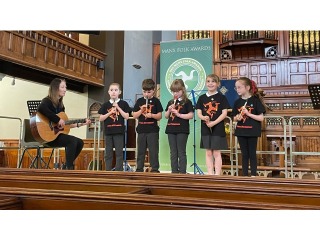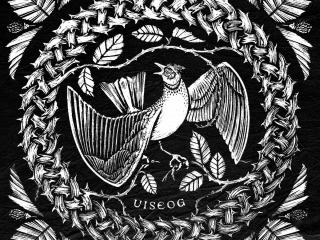MENU
07 Dec 2017
Nollick Ghennal as Blein Vie Noa – Merry Christmas and Happy New Year
Manx music and dance at Christmas
‘At Christmas play and make good cheer, For Christmas comes but once a year’.
In the Isle of Man, a key element of Christmas in past-times was taking a break from routine. This holiday from the usual hard and relentless routine was called the ‘Foolish Fortnight’ or in Manx Gaelic, ‘Yn Kegeesh Ommidjagh’, and this began on the shortest day, Black Thomas’ Eve (now 21st December) and ended on Twelfth Night (6th January or Old Christmas Day).
Much like today, ‘Foolish Fortnight’ was a time of socialising and revelry. Very little work was done; the time instead spent singing, dancing, eating, drinking, dancing, sports, games and visiting. Fiddlers were hired during Christmas to play for dancing and their fee was known as ‘Yn Unnysup’ – a word thought to be linked to Wanderer’s cup or Wandescope and which features in several tune titles. And before carol-singing from house to house became part of Christmas, there was the ‘Mollag Band’ – a motley crew of men dressed in disguise who took to the streets singing loudly, banging drums and generally making a nuisance of themselves until they were paid to go away! The ‘mollag’ was the inflated sheep’s bladder which was fastened to the end of a stick and used to threaten those who wouldn’t pay!
A tradition associated with Christmas in the Isle of Man and elsewhere in the British Isles was the the White Boys mummers’ play. Referring to local topics and current affairs, the folk drama features St. George who fights various opponents who are then brought back to life by the Doctor! Usually performed by men, the characters were dressed in white dresses decorated with ribbons, beads and tinsel and high hats decorated with evergreens. The performance also included the White Boys Carol and the impressive White Boys Dance where blunt-edged swords were interlinked into a 6 pointed star performed to the tune, “Creg Willy Syl”.
Carvals at the Oie’l Verrey
Another tradition peculiar to the Isle of Man was the singing of Carvals on the Oie’l Verrey (Eve of the Feast of Mary or Christmas Eve). When the evening service was over and the vicar had gone home, the Parish Clerk and congregation stayed in the church to perform or listen to carvals (carols) in Manx Gaelic. These carvals rarely referred to the nativity, but instead to matters of Christian duty, judgment, salvation, redemption, the joys of heaven and the terrors of hell! They were usually performed unaccompanied by a male singer and the duration was determined either by the length of time taken to walk and sing from the back of church to the altar, or the length of time a lit taper lasted until the flame went out. Some carvals were 320 verses long! Friendly rivalry was part of the evening as the congregation would shout encouragement at the end of each verse, or the women would fling parched peas at their bachelor friends! Afterwards, all retired to nearest tavern for hot spiced ale and they ended the evening in the small hours by singing ‘Arrane Oie Vie’ – the Goodnight song or Parting Song.
A.W. Moore published a collection of carval text manuscripts in Carvalyn Ghailckagh (1891) and many of the melodies were taken down by Dr Clague and the Gill Brothers in the 1890s. e.g. “Carval ny Drogh Vraane”.
Christmas Day
Early on Christmas morning, fiddlers called on households to wake everyone up to receive their gifts!
Hunt the Wren – Shelg yn Drean
Another music and dance tradition that has been continuous in the Isle of Man is Hunt the Wren or Shelg yn Drean which is performed on St. Stephen’s Day. In the past, people would beat the bushes to catch a wren and kill it, before parading the bird in a bush decorated with evergreens and ribbon. The traditional circle dance is performed around the bush to a lively song. Similar to the legends found in surrounding islands, one story behind the tradition is that a wren betrayed St. Stephen by alerting Roman soldiers to the bush where he was hiding. Another tells of a beautiful siren who lured Manx men into the sea to their deaths. When one attempted to catch her, she turned into a wren and escaped, so each year since, men and boys tried to catch the bird. A feather from a hunted-down wren was considered very lucky as it gave protection against shipwrecks and witchcraft. Hunt the Wren revellry must be finished by midday, when it then customary to gather on Tynwald Fairfield for the annual cammag match between the North and South; a dangerous stick and ball game similar to hurling and shinty!
The party is over!
Twelfth Night marked the end of Kegeesh Ommidjagh (foolish fortnight), and this was known as Laa Giense, a feast day when young people were paired off. Just in time for back to work!
CHRISTMAS GREETINGS IN MANX
Nollick Ghennal as Blein Vie Noa = Happy Christmas and a Good New Year
Lesh yeearreeyn share = With best wishes
Lesh Shee as Graih = With peace and love
Hee’m oo ‘sy vlein noa = See you in the New Year
Shee erriu car ny bleeaney shoh çheet = Peace to you throughout the coming year.
A traditional Christmas greeting is as follows:
Nollick Ghennal erriu, as blein feer vie
Seihll as slaynt da’n slane lught-thie;
Bea as gennallys eu bio ry-cheilley,
Shee as graih eddyr mraane as deiney
A Merry Christmas to you, and a very good year
Long life and health to the whole household;
Life and joy to you living together,
Peace and love between women and men.
Christmas Card = Kaart Nollick / Christmas Carol = Carval / Christmas Day = Laa Nollick / Christmas Eve = Oie’ll Voirrey / Christmas Tree = Billey Nollick / Father Christmas = Jishag y Nollick / Snowman = Fer sniaghtee / Shelg yn drean = Hunt the wren
More about Manx culture: www.culturevannin.im

Manx Folk Awards 2025 RESULTS
01 Apr 2025
Read More...
Little Red Bird - the island's most popular and well-travelled lullaby
31 Mar 2025
Read More...
North American Manx Association awards seeks nominees
04 Mar 2025
Read More...
Contact, Links, Acknowledgements, Privacy
© Culture Vannin. Culture Vannin is the trading name for the Manx Heritage Foundation, registered charity 333 in the Isle of Man. Designed by 3 Legs Ltd.